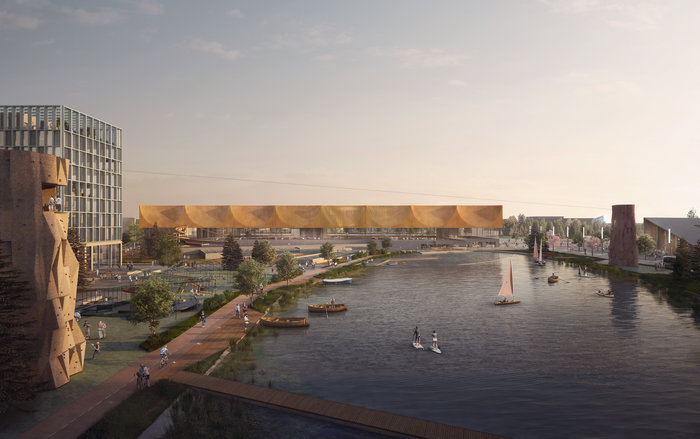Norwegian-based Haptic Architects and Nordic – Office of Architecture have unveiled their winning designs for the masterplan for Oslo Airport City (OAC), a new model for a sustainable smart city located adjacent to Oslo Airport.
The 4,000,000m² (43,000,000ft²) city, is set to be powered entirely by renewable energy, served by electric vehicles and will take 30 years to build. OAC aims to be the first energy positive airport city with the capacity to sell surplus energy to surrounding buildings, communities and cities. It will also be able to provide crucial on-site provision such as the de-icing of airplanes.
Backed by the Norwegian government’s shift from an oil-based economy to one powered by renewable energy, OAC will embrace low-carbon features and green technologies. The city will be a testbed for a technology-driven city, with plans to incorporate driverless electric cars, auto-lighting and smart technology for services such as mobility, waste and security.
Catering to Norway’s passion for sports and outdoor activities, OAC will be a destination for leisure activities centered around a public park in addition to the traditional cargo and business hub. A car-free city center is planned, and its citizens will never be more than five minutes away from public transport. It will also include generous provision of green spaces for the airport’s growing workforce, which is expected to increase from 22,000 to 40,000 people by 2050.
Tomas Stokke, director, Haptic Architects, said, “This is a unique opportunity to design a new city from scratch. Using robust city planning strategies such as walkability, appropriate densities, active frontages and a car-free city center, combined with the latest developments in technology, we will be able to create a green, sustainable city of the future.
“Capitalizing on the central location in Northern Europe, a highly skilled workforce and proximity to an expansive and green airport, OAC has all the ingredients needed to make this a success. This is the most exciting type of project we can do as architects and I am very proud to be part of it.”
Thor Thoeneie, managing director of OAC, added, “The airport city will be a catalyst for high-value economic activity in Norway. We expect it to deliver long-term, highly skilled jobs creating science and technology-based products as well as providing employment in services such as specialized healthcare and executive education and training.”
OAC has received outline planning consent for general development and detailed consent for some areas. Construction of the first stage is expected to start in 2019/20, with the first buildings completed in 2022.

